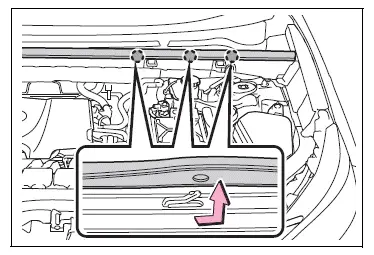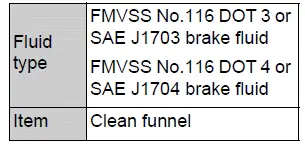Toyota RAV4 (XA50) 2019-2025 Owners Manual: Checking and adding the brake fluid
â– Checking fluid level
The brake fluid level should be between the "MAX" and "MIN" lines on the tank.

â– Adding fluid
1. Slide and lift up the rubber strip to partly remove it as shown.

2. Disconnect the claws and remove the service cover.

3. Remove the reservoir cap.

4. Add brake fluid slowly while checking the fluid level.
Make sure to check the fluid type and prepare the necessary item.

â– Brake fluid can absorb moisture from the air
Excess moisture in the brake fluid can cause a dangerous loss of braking efficiency. Use only newly opened brake fluid.
WARNING
â– When filling the reservoir
Take care as brake fluid can harm your hands and eyes and damage painted surfaces.
If fluid gets on your hands or in your eyes, flush the affected area with clean water immediately.
If you still experience discomfort, see a doctor.
NOTICE
â– If the fluid level is low or high
It is normal for the brake fluid level to go down slightly as the brake pads wear out or when the fluid level in the accumulator is high.
If the reservoir needs frequent refilling, there may be a serious problem.
 Checking the coolant
Checking the coolant
The coolant level is satisfactory
if it is between the "FULL" and
"LOW" lines on the reservoir
when the engine is cold.
Reservoir cap
"FULL" line
"LOW" line
If the level is on or below the "LOW" ...
 Checking the battery
Checking the battery
Check the battery as follows.
â– Battery exterior
Make sure that the battery terminals
are not corroded and that
there are no loose connections,
cracks, or loose clamps.
Terminals
Hold-down clamp ...
Other materials:
Installation
Install front bumper side retainer lh
Install the clip and bumper side retainer.
Install the bolt.
Torque: 6.0 N*m (61 kgf*cm, 53 in.*Lbf)
Install front bumper side retainer rh
Hint:
Use the same procedures described for the lh side.
Install front bumper reinforcemen ...
Installation
Caution:
Be sure to read the precautionary notices concerning the
srs airbag system before servicing it (see page rs-1).
Install front passenger airbag assembly
Attach the rear side hook of the front passenger
airbag to the rear side airbag door.
Bend the front side hook so that it a ...
Dtc check / clear
Check dtc
Connect the intelligent tester (with can vim) to the
dlc3.
Turn the ignition switch on and turn the intelligent
tester on.
Read the dtc by following the prompts on the
tester screen.
Hint:
Refer to the intelligent tester operator's manual for
further details.
...
